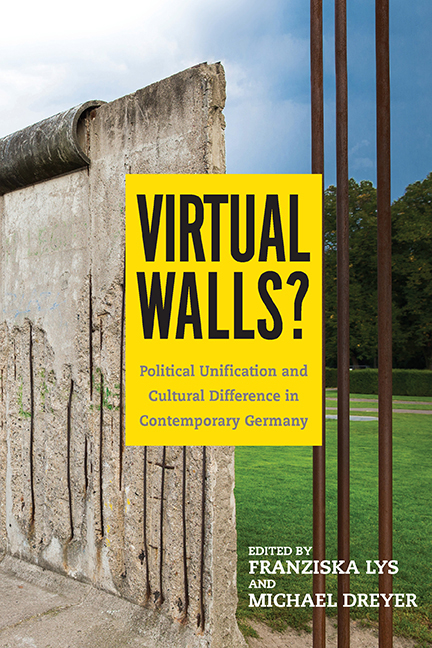Book contents
- Frontmatter
- Dedication
- Contents
- Acknowledgments
- Introduction: United Politics—Divided Culture?
- Part I What Remains: History and the Constitution
- Part II What and How Do We Remember? Literature, Film, and Exhibitions
- 3 East German Literature and Reunification: Continuities and Discontinuities
- 4 The Afterlife of the GDR in Post-Wall German Cinema
- 5 Exhibiting 1989/2009: Memory, Affect, and the Politics of History
- Part III A Changing Reception: Painting, Orchestras, and Theaters
- Part IV A Virtual Wall? Education and Society
- Epilogue: The Wende and the End of “the German Problem”
- Notes on the Contributors
- Index
5 - Exhibiting 1989/2009: Memory, Affect, and the Politics of History
from Part II - What and How Do We Remember? Literature, Film, and Exhibitions
Published online by Cambridge University Press: 24 August 2019
- Frontmatter
- Dedication
- Contents
- Acknowledgments
- Introduction: United Politics—Divided Culture?
- Part I What Remains: History and the Constitution
- Part II What and How Do We Remember? Literature, Film, and Exhibitions
- 3 East German Literature and Reunification: Continuities and Discontinuities
- 4 The Afterlife of the GDR in Post-Wall German Cinema
- 5 Exhibiting 1989/2009: Memory, Affect, and the Politics of History
- Part III A Changing Reception: Painting, Orchestras, and Theaters
- Part IV A Virtual Wall? Education and Society
- Epilogue: The Wende and the End of “the German Problem”
- Notes on the Contributors
- Index
Summary
AFTER THE FALL of the Wall in 1989, Germany entered a veritable exhibition boom. The frenzied pace of exhibition and museum openings peaked at the turn of the millennium, when an average of more than one new museum opened its doors to the public every other day (Rauterberg 2002, 43). The end of the Cold War brought a windfall to economic and cultural globalization. At the same time, new digital technologies revolutionized the way we communicate, trade, and go about our lives. While digital technologies also impacted museum culture, where they enabled the creation of new immersive environments, object-based history exhibitions and art exhibitions soared as well, attracting ever more visitors through special events and other innovative programs. This explosive growth, in some respects a permutation of what came to be known globally as the “Guggenheim effect” of the 1980s, had specific resonances in postunification Germany. After 1989, the reconfigured state and its regions turned to the medium of exhibition to work through the divided past—including the differently lived legacies of World War II, Nazism, and the Shoah—and to reflect on the transformation of the present. Across the newly unified nation-state, museum and memory culture during the 1990s worked with an array of new exhibition concepts in regional museums and Gedenkstätten (memorial sites) devoted to Nazi militarism and perpetration. The Topography of Terror exhibit in Berlin that opened in 1987 on the site of the former Gestapo headquarters, for instance, has since grown into a full-scale museum and documentation center. While still considered a “difficult heritage” overdetermined by trauma, mourning, guilt, and shame, the history of Nazism and the genocide of European Jewry now have a firm place in virtually every contemporary regional or history museum in Germany. The aesthetics of these proliferating exhibitions, however, have varied greatly, from the Topography of Terror's sober documentary style, to the experiential, Erlebnis-oriented presentation at the Historisch-Technisches Museum Peenemünde, to the concept of the Nazi Bunker Valentin in Bremen-Fargo as Denkort, “a place to think but also to remember” (Heckner 2016, 369).
In her review of recent site-specific exhibitions with a focus on Nazi militarism, Elke Heckner (2016) sheds light on the installations of the Bremen Bunker, the site of a former Nazi submarine wharf.
- Type
- Chapter
- Information
- Virtual Walls?Political Unification and Cultural Difference in Contemporary Germany, pp. 96 - 114Publisher: Boydell & BrewerPrint publication year: 2017

